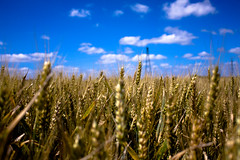Chapter 10 Vocabulary for AP Biology
| 5107740887 | Chlorophyll | Green Pigment Main photosynthetic pigmnet Absorbs primarily violet-blue and red wavelengths |  | 0 |
| 5107740888 | Mesophyll | primary site for photosynthesis the tissue in the interior of a leaf | 1 | |
| 5107740889 | Stomata | CO2 enters and O2 exits through these pores Bottom of a leaf | 2 | |
| 5107740890 | Vascular Tissue | veins which transport water from the roots and sugar from leaves to nonphotosynthesis parts of the plant. | 3 | |
| 5107740891 | Stroma | dense fluid within chloroplast | 4 | |
| 5107740892 | Thylakoids | dense interconnected membranous sacs |  | 5 |
| 5107740893 | Thylakoid Space | interior of a thylakoid | 6 | |
| 5107740894 | Thylakoid lumen | interior of a thylakoid | 7 | |
| 5107740895 | Grana | stacks of thylakoid | 8 | |
| 5107740896 | Granum | singular of grana | 9 | |
| 5107740897 | Chloroplast | sites of photosynthesis | 10 | |
| 5107740898 | Photosynthesis | conversion of light energy into chemical energy stored in sugar and other organic molecules |  | 11 |
| 5107740899 | Photosynthesis Equation | 6 CO2 + 6 H2O + light --> C6H12O6 + 6 O2 | 12 | |
| 5107740900 | Carbon Dioxide | source of carbon and is considered inorganic carbon | 13 | |
| 5107740901 | Electromagnetic Spectrum | Electromagnetic Energy which travels in waves |  | 14 |
| 5107740907 | Colors | Light we see is reflected off objects and light we dont see is absorbed by objects | 15 | |
| 5107740910 | White | All colors reflected | 16 | |
| 5107740911 | Black | All colors absorbed | 17 | |
| 5107740914 | Chlorophyll a | main photosynthetic green pigment, absorbs primarily violet-blue and red wavelengths | 18 | |
| 5107740915 | Pigment | a molecule that absorbs wavelengths in the visible light spectrum | 19 | |
| 5107740918 | Carotenoid | absorbs blue and blue-green wavelengths Beta-Carotene; gives materials an orange color | 20 | |
| 5107740919 | Light Reactions | Occur in thylakoid membrane and are also called light dependent reactions | 21 | |
| 5107740920 | Photophosphorylation | Light is captured by pigments and used to convert ADP + Pi into ATP | 22 | |
| 5107740921 | Photosystem | Consists of a reaction-center complex surrounded by light-harvesting complexes | 23 | |
| 5107740922 | Light-Harvesting Complex | Contains chlorophyll a, chlorophyll b, and carotenoids (within the photosystem) | 24 | |
| 5107740924 | Photosystem 1 | Has P700 chlorophyll a in reaction-center complex |  | 25 |
| 5107740925 | Photosystem 2 | Has P680 chlorophyll a in reaction-center complex | 26 | |
| 5107740928 | Cytochrome | Iron-containing carrier protein also found in mitochondrial electron transport (specific name of ETC protein) | 27 | |
| 5107740929 | Cyclic Electron Flow | Produces only ATP Takes place in thylakoid membrane Not as efficient as non-cyclic because no NADPH is produced Water is not split; O2 not produced Evolutionary Leftover | 28 | |
| 5107740930 | Lumen | Thylakoid Space | 29 | |
| 5107740931 | Calvin Cycle | Light-Independent reactions Occurs in stoma, does not use light directly |  | 30 |
| 5107740933 | Rubisco | The most abundant protein on Earth Carbon Fixation is catalyzed by Rubisco | 31 | |
| 5107740934 | Reduction | The carbon molecules made in Carbon Fixation are reduced into to G3P that can be used to make glucose or perform other processes | 32 | |
| 5107740935 | 1 Cycle of Calvin Cycle | 1 CO2 is fixed 3 ATP are used 2 NADPH are used 1 RuBP is regenerated 6 cycles needed to make 1 glucose molecule | 33 | |
| 5107740937 | C4 Photosynthesis | A method that bypasses photorespiration Happens in corn, sugarcane, and other plants in hot, dry environments Moves from mesophyll to bundle-sheath cells | 34 | |
| 5107740938 | CAM Photosynthesis | A method to bypass photorespiration Happens in water-storing plants such as cacti and pineapples At night stomata opens and carbon dioxide is taken in and is fixed into a variety of organic acids During the day, organic acids release CO2 and can be used for Calvin Cycle |  | 35 |
| 5107740939 | C3 Plant | Calvin cycle, taking in carbon dioxide through the leaves' minuscule pores, called stomata. An enzyme called RuBisCO helps the carbon dioxide combine with sugar. |  | 36 |

